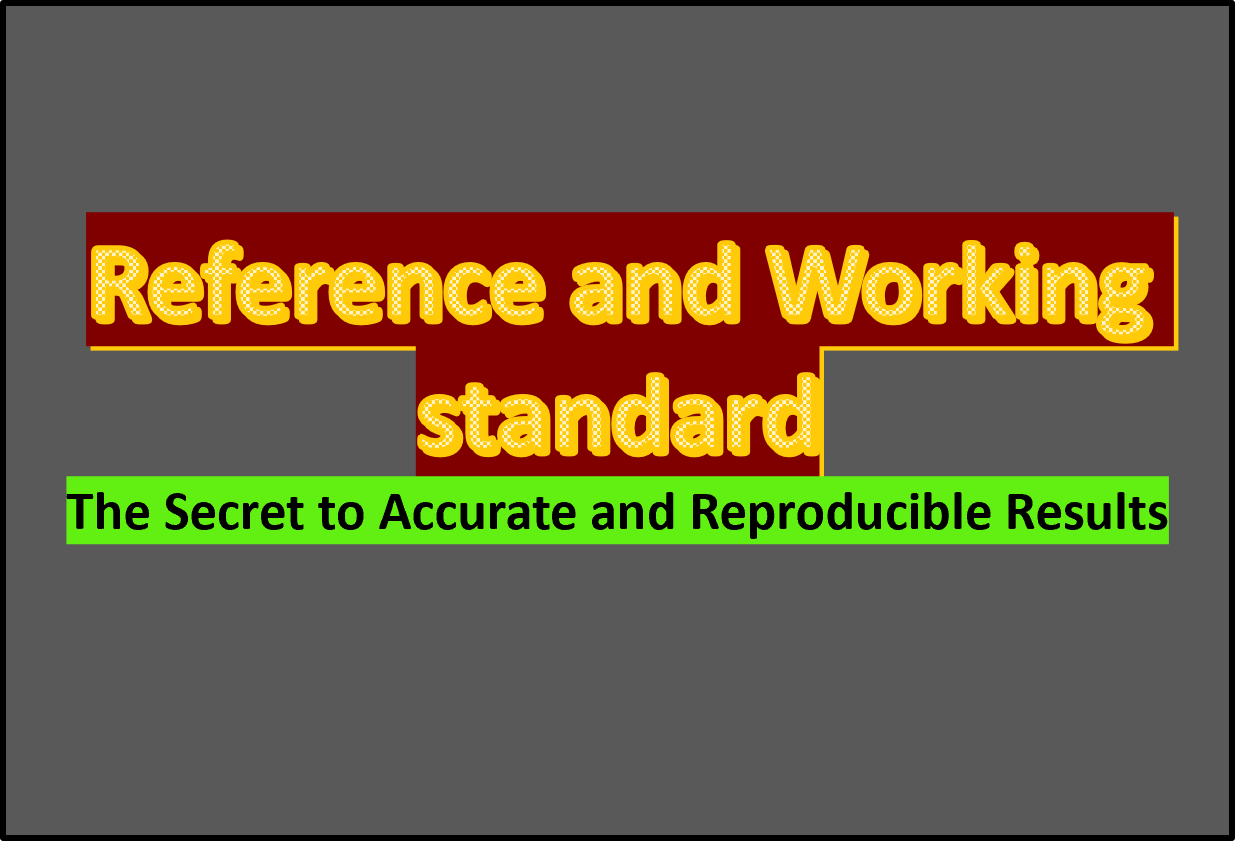Working and Reference Standards: The Secret to Accurate and Reproducible Results

In involves the information on working standard, Reference standard, difference among them, Advantages and Limitations and Frequently asked questions.
Working and Reference Standards: The Secret to Accurate and Reproducible Results
What is mean by Reference Standard?
A Reference standard is also called as primary standards and used to verify quality, safety and potency of the pharmaceutical products during development stages and marketed products as well. These standards are established by a recognized authority, such as the US Pharmacopeia (USP) ,European Pharmacopeia (EP) ,British pharmacopoeias (BP) or the National Institute of Standards and Technology (NIST).
These standards are used to verify the accuracy of analytical methods, instruments and working standards. These standards are considered to be the benchmark for comparison. Pharmaceutical industries and testing laboratories procuring standards from these recognized authorities.
These standards also called as Primary standards. Primary standards are used to calibrate secondary standards.
What is mean by Working Standard?
A working standard is a standard that is also called as secondary standards used to calibrate or verify the accuracy, Quality and potency of an Marketed drug products . Working standards are typically prepared in-house i.e. in laboratory and are used on a regular basis to ensure that the analytical results obtained from the method or instrument are accurate and precise. These standards can be used only if they are standardized against primary standards (Reference standards) using definitive method that are published in pharmacopoeias or national or international standards.
What is the use of Reference standard and working standard in Laboratory ?
Reference standard is primarily used to qualify the secondary standards i.e. working Standards moreover it can be suitable to use to test the identity, strength, quality and purity of substances for pharmaceutical use and Medicinal products.
Working standards is used to test the identity, strength, quality and purity of substances for pharmaceutical use and Medicinal products.
Who will Supply Primary and Secondary standards ?
Primary Reference standards are substances manufactured and tested by a Recognized Authority/Certified source. The certified/Authorized sources from which these reference standards can be received from US pharmacopoeias (USP), European pharmacopeia (EP) etc.
Chemical and Biological standards can be purchased from below authorities
- USP – (USP Reference Standard catalog)
- BP,EP
- USA Bureau for Biologics
- USA National bureau of standards
- WHO for biologicals
- ANSI (American National Standards Institute)
- NIST (National Institute of Standards and Technology)
How to procure Reference standards for your Quality Control Testing Laboratory ?
You can procure the Reference standards by contacting them by providing the below details with payment Terms.
- Reference standard Name or Pharmacopeial catalog Number.
- Bottles Quantity with Reference standard weight ( eg : 5 X 10 mg bottle)
- Copy of purchase order and Import license.
- Send the above information by registered mail ID to authorized Dealer or Directly can be sent to Pharmacopeial authority for Reference standards
- If pharmacopeia asked for the statement of use for the ordered reference standards its benefited to provide the same on letter of statement.
- Need to follow local regulatory guidelines too for importing of reference standard if required.
How to Prepare working standard (secondary standards) in house i.e. in Laboratory?
Plz Follow and ensure below points while preparing the working standards in House.
working standard can be prepared from the Raw material (Active Pharmaceutical Ingredient- API ) received from manufacturer/Vendor at the factory premises.
After receipt of API consignment, It should be sampled in warehouse and tested it in quality control laboratory against the corresponding available reference standard or established working standards to determine its Assay, purity and Accuracy.
Check the vendors certificate of analysis of received material for its retest or expiry dates, it will help to get the longer shelf life to sample.
If the new raw material sample is tested against the established working standard try not to use same batch number for both.
New Raw material sample used for preparation of working standard, same batch should not be used to manufacture the finished product.
If another raw material is not available, in that case existing raw material can be used for Manufacturing of finished products. But another analytical grade available API need to purchase in small quantity and qualify it against the reference standard to convert it in to working standard.
If analytical grade material is not available then the same batch working standard sample can be used to analyze the finished goods which is manufactured with same batch number unless and until used working standard material is qualified against the reference standard before use.
How to evaluate the Expiry Dates and Retest Date for Reference Standard ?
Now a days the “Expiry date” Terminogly is being used as “used by date” and some of the reference standards will mention as “Retest Date”
Expiry date it defines that beyond that date sample can bot be used.
Retest date defines that beyond this date sample can not used, unless and until it has been retesting and confirmed to suitable for further use. till this retest date can be extended further.
Provided shelf life for Reference standard is 18 month after opening the bottle, in this case expiry period published in pharmacopeias is within this period. Pharmacopeial expiry date will be taken in to consideration at first priority before using it. If reference standard is utilized for identification test, once opened it can be used util the expiry dates are published by the pharmacopeia. Unless special considerations applicable for some samples.
working standards should be retest inhouse against the available reference standards. Retest date will be considered maximum for one year the date of analysis. But the reference sample will not be used further beyond expiry/Retest date or available Documented stability time point. Where such type of dates like expiry date or Retest date not available on the bottle it indicate that sample can be used further.
What type of information should be maintained in Reference and Working Standard Log Book ?
Reference standard : In reference standard register information should be recorded such as Purchased date, Pharmacopeia catalog number, Name of active ingredient, Number of vials, expiry date and PO number etc. Separate Column is available to check the expiry dates of reference standard against the pharmacopeial catalog by the competent technical staff.
Working standard : In Working standard register information should be recorded such as Raw material batch number, Purity, Assay, Expiry/Retest Date, Number of vials and current vials in use etc.
what is the use of Reference and working standards in pharmaceutical industry.
Frequently asked Questions (FAQs)
How do you prepare a working standard?
Working standards are typically prepared in-house i.e. in laboratory itself comparing against the Reference Standards . The preparation must be carefully controlled to ensure that they meet the required specifications for accuracy, Concentration (Assay) and purity.
Can a Reference standard also be used as a working standard?
Yes, a reference standard can also be used as a working standard, but it must be carefully controlled to ensure that it meets the required specifications for accuracy and precision.
How often should Working standards be recalibrated?
Working standards should be recalibrated on a regular basis, Generally it should be calibrated every 1 years, to ensure that they continue to meet the required specifications for accuracy, Concentration (Assay) ,Precision and purity.
What happens if a working standard does not meet the required specifications?
If a working standard does not meet the required specifications for accuracy and precision, it cannot be used to calibrate or verify the accuracy of an analytical method or instrument. The standard must be re-prepared or replaced to ensure accurate and reliable results.


